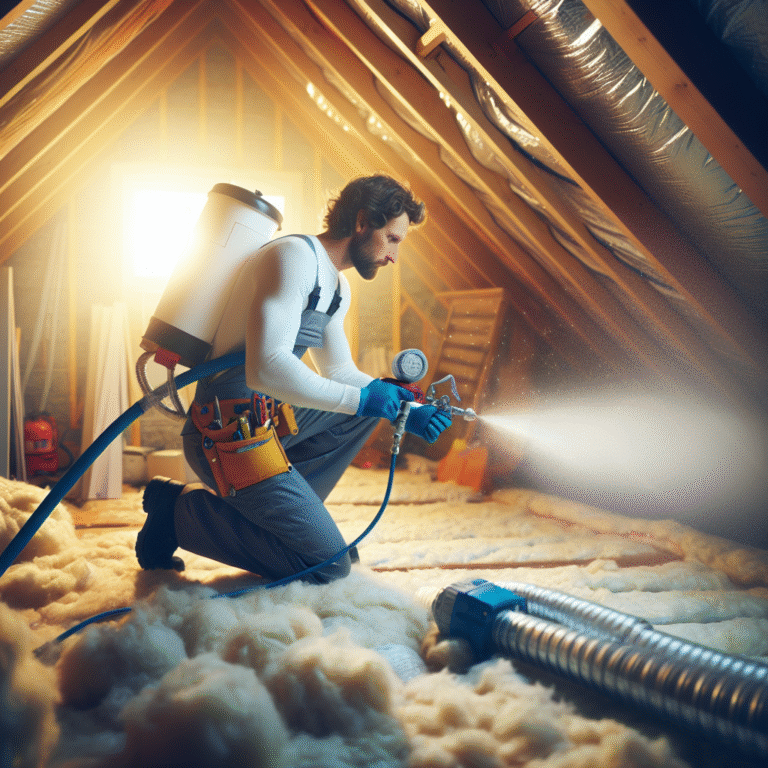-
Table of Contents
Say goodbye to unwanted pests with blown-in insulation – the ultimate barrier against mice and insects.
“Say goodbye to pesky mice and insects in your home with our blown-in insulation services. Keep your home safe and comfortable with Texas Insulation Solution. Visit texasinsulationsolution.com to learn more and schedule your insulation installation today!”
Introduction
Blown-in insulation is a highly effective and efficient way to keep your home warm in the winter and cool in the summer. But did you know that it can also help keep unwanted pests out of your home? Say goodbye to mice and insects with blown-in insulation, as it creates a barrier that makes it difficult for these pests to enter your home. In this article, we will explore how blown-in insulation can help protect your home from unwanted visitors and provide a more comfortable living environment for you and your family.
Benefits of Blown-In Insulation for Keeping Mice and Insects Out
When it comes to keeping your home safe and comfortable, insulation is a crucial factor. Not only does it help regulate the temperature inside your house, but it also plays a significant role in keeping unwanted pests out. Mice and insects are common household pests that can cause damage and spread diseases. Fortunately, blown-in insulation is an effective solution for keeping these pesky creatures out of your home.
Blown-in insulation, also known as loose-fill insulation, is a type of insulation that is installed by blowing or spraying it into walls, attics, and other spaces. It is made up of small particles of materials such as fiberglass, cellulose, or mineral wool. This type of insulation is highly recommended for its ability to fill in small gaps and crevices, making it an excellent barrier against pests.
One of the main benefits of blown-in insulation is its ability to keep mice out of your home. Mice are small and can easily squeeze through tiny openings in your walls or attic. They are also excellent climbers and can make their way into your home through the roof. However, with blown-in insulation, these small openings are sealed, making it difficult for mice to enter.
Moreover, blown-in insulation is also effective in keeping insects out of your home. Insects such as cockroaches, ants, and termites can cause significant damage to your property and pose health risks to you and your family. They can enter your home through small cracks and gaps in your walls, floors, and ceilings. Blown-in insulation fills in these gaps, creating a barrier that insects cannot penetrate.
Another advantage of blown-in insulation is that it is a long-lasting solution. Unlike traditional insulation methods, which can settle and become less effective over time, blown-in insulation maintains its density and effectiveness for many years. This means that you won’t have to worry about pests finding their way into your home due to gaps in your insulation.
Furthermore, blown-in insulation is a more eco-friendly option compared to other insulation materials. It is made from recycled materials, making it a sustainable choice for your home. Additionally, it does not contain harmful chemicals, making it safe for both your family and the environment.
Aside from keeping pests out, blown-in insulation also has other benefits for your home. It helps regulate the temperature inside your house, keeping it warm in the winter and cool in the summer. This can lead to significant energy savings and lower utility bills. It also reduces noise levels, making your home a more peaceful and comfortable place to live in.
Moreover, blown-in insulation is a cost-effective solution for pest control. While other methods such as traps and pesticides may provide temporary relief, they can be costly and may not be as effective in the long run. Blown-in insulation, on the other hand, is a one-time investment that can provide long-term protection against pests.
In conclusion, blown-in insulation is an excellent solution for keeping mice and insects out of your home. Its ability to fill in small gaps and crevices makes it an effective barrier against these pests. It is also a long-lasting, eco-friendly, and cost-effective option for insulation. So say goodbye to mice and insects and hello to a pest-free home with blown-in insulation.
How Blown-In Insulation Can Save You Money on Pest Control
Pest control is a common concern for homeowners, and for good reason. Mice and insects can cause damage to your property, spread diseases, and create an uncomfortable living environment. Many people turn to traditional methods of pest control, such as traps and pesticides, to keep these unwanted guests at bay. However, there is another solution that not only helps with pest control but also saves you money in the long run – blown-in insulation.
Blown-in insulation is a type of insulation that is installed by using a blowing machine to distribute loose insulation material into walls, attics, and other spaces. This method of insulation has been gaining popularity in recent years due to its many benefits, including its ability to help with pest control.
One of the main ways blown-in insulation can save you money on pest control is by creating a barrier that pests cannot easily penetrate. Traditional insulation materials, such as fiberglass batts, can leave small gaps and spaces where pests can enter your home. Blown-in insulation, on the other hand, fills these gaps and creates a tight seal, making it difficult for pests to find their way in. This not only keeps pests out but also helps to maintain a consistent temperature in your home, reducing the likelihood of pests seeking shelter in your walls or attic.
Furthermore, blown-in insulation is made of materials that are not attractive to pests. Fiberglass batts, which are commonly used in traditional insulation, can be a cozy nesting spot for rodents and insects. Blown-in insulation, on the other hand, is typically made of materials such as cellulose or mineral wool, which are not appealing to pests. This means that even if pests do manage to find their way into your walls or attic, they are less likely to make a home there.
In addition to creating a barrier and using unappealing materials, blown-in insulation can also help with pest control by reducing moisture in your home. Moisture is a major attractant for pests, and traditional insulation materials can trap moisture, creating the perfect environment for pests to thrive. Blown-in insulation, on the other hand, is able to absorb and release moisture, helping to keep your home dry and less appealing to pests.
Another way blown-in insulation can save you money on pest control is by reducing the need for pesticides. Pesticides can be expensive and can also pose health risks to you and your family. By creating a barrier and reducing moisture, blown-in insulation can significantly decrease the likelihood of pests entering your home, thus reducing the need for pesticides. This not only saves you money but also helps to create a safer and healthier living environment.
Furthermore, blown-in insulation can also save you money on energy costs. By creating a tight seal and maintaining a consistent temperature in your home, blown-in insulation can help to reduce your heating and cooling bills. This means that not only are you saving money on pest control, but you are also saving money on your overall energy costs.
In conclusion, blown-in insulation is a cost-effective and efficient way to not only insulate your home but also to help with pest control. By creating a barrier, using unappealing materials, reducing moisture, and saving on energy costs, blown-in insulation can save you money in the long run. So say goodbye to mice and insects and hello to a more comfortable and pest-free home with blown-in insulation.
The Process of Installing Blown-In Insulation to Keep Mice and Insects Away
When it comes to keeping your home safe and comfortable, insulation is a crucial factor. Not only does it help regulate the temperature inside your house, but it also acts as a barrier against unwanted pests. Mice and insects can easily find their way into your home through small cracks and gaps, but with the right insulation, you can say goodbye to these pesky intruders. Blown-in insulation, in particular, is an effective and efficient way to keep mice and insects away from your home. In this article, we will discuss the process of installing blown-in insulation and how it can help protect your home from these unwanted guests.
The first step in installing blown-in insulation is to assess your home’s current insulation situation. This involves checking for any existing insulation and determining its condition. If you have old or damaged insulation, it is recommended to remove it before installing blown-in insulation. This will ensure that the new insulation is properly installed and will provide maximum protection against mice and insects.
Once the old insulation has been removed, the next step is to prepare the area for blown-in insulation. This involves sealing any cracks or gaps in the walls, floors, and ceilings. These small openings can serve as entry points for mice and insects, so it is crucial to seal them off before installing the insulation. This step also helps to improve the overall energy efficiency of your home.
After the preparation is complete, the blown-in insulation can be installed. This type of insulation is made up of small particles of materials such as fiberglass, cellulose, or mineral wool. These particles are blown into the walls, floors, and ceilings using a special machine. The machine breaks up the insulation material and blows it into the designated areas, filling up any gaps and creating a thick layer of insulation.
One of the main advantages of blown-in insulation is its ability to reach even the smallest and hard-to-reach areas of your home. This ensures that every nook and cranny is properly insulated, leaving no room for mice and insects to enter. The insulation material is also treated with a pest repellent, making it even more effective in keeping these unwanted guests away.
Once the insulation is blown in, it is important to let it settle for a few hours before moving on to the next step. This allows the insulation to expand and fill any remaining gaps, ensuring a complete and thorough installation. After the settling period, the excess insulation is removed, and the walls, floors, and ceilings are sealed back up.
The final step in the process is to clean up the area and make sure everything is back in place. Blown-in insulation is a clean and non-invasive process, so there is minimal mess and disruption to your home. You can now enjoy a well-insulated home that is protected from mice and insects.
In conclusion, blown-in insulation is an effective and efficient way to keep mice and insects away from your home. The process involves assessing your current insulation, preparing the area, installing the insulation, and cleaning up. With blown-in insulation, you can say goodbye to the hassle of dealing with unwanted pests and enjoy a comfortable and pest-free home. So, if you want to keep your home safe and secure, consider installing blown-in insulation today.
Q&A
1. What is blown-in insulation?
Blown-in insulation is a type of insulation material that is installed by blowing it into walls, attics, and other spaces using specialized equipment. It is typically made of materials such as fiberglass, cellulose, or mineral wool and helps to improve the energy efficiency of a building by reducing heat loss.
2. How does blown-in insulation help to keep mice and insects out?
Blown-in insulation creates a barrier between the interior and exterior of a building, making it difficult for mice and insects to enter. The insulation also fills in any small cracks or gaps in walls and attics, which are common entry points for pests. Additionally, some blown-in insulation materials, such as cellulose, are treated with borates which act as a natural insect repellent.
3. Is blown-in insulation a safe and effective way to get rid of mice and insects?
Yes, blown-in insulation is considered a safe and effective method for keeping mice and insects out of a building. It is non-toxic and does not use any harmful chemicals. Additionally, the insulation is tightly packed and does not leave any gaps or spaces for pests to enter. However, it is important to properly seal any existing entry points before installing the insulation to ensure maximum effectiveness.
Conclusion
In conclusion, blown-in insulation is an effective and environmentally friendly solution for keeping mice and insects out of homes. Its ability to fill in small gaps and crevices makes it difficult for pests to enter, and its non-toxic nature ensures the safety of both humans and animals. By properly insulating our homes, we can say goodbye to the annoyance and potential health hazards caused by mice and insects. Blown-in insulation is a smart and practical choice for any homeowner looking to protect their home from unwanted pests.




